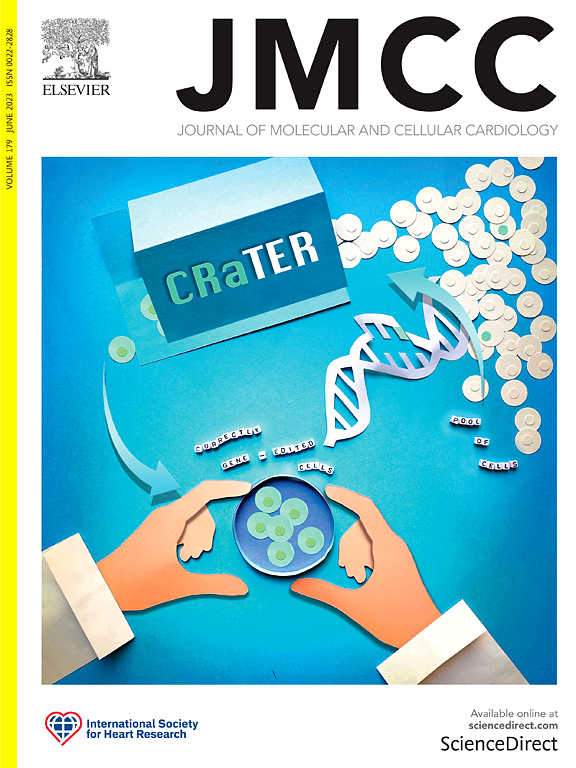Gain and loss of the centrosomal protein taxilin-beta influences cardiac proteostasis and stress
IF 4.7
2区 医学
Q1 CARDIAC & CARDIOVASCULAR SYSTEMS
引用次数: 0
Abstract
Centrosomes localize to perinuclear foci where they serve multifunctional roles, arranging the microtubule organizing center (MTOC) and anchoring ubiquitin proteasome system (UPS) machinery, as suggested by prior studies. In mature cardiomyocytes, centrosomal proteins redistribute into a specialized perinuclear cage-like structure, and a potential centrosomal-UPS interface has not been studied, despite established roles for UPS in cardiomyopathy. In addition, there have been no reports citing cardiomyocyte UPS dysfunction upon or after manipulation of centrosomal proteins. Taxilin-beta (Txlnb), a cardiomyocyte-enriched protein, belongs to a family of centrosome adapter proteins implicated in protein quality control. We hypothesize that Txlnb is part of the perinuclear centrosomal cage and regulates proteostasis in cardiomyocytes. Herein, we show that centrosome proteins, including Txlnb, have significantly broadly dysregulated RNA expressions in failing hearts; however, Txlnb protein levels appear to be unchanged. Reanalysis of Txlnb's interactome supports its involvement in cytoskeletal, microtubule, and UPS processes, particularly centrosome-related functions. Using gain and loss of function approaches, in cells and mice, we show that Txlnb is a novel regulator of cardiac proteostasis through its influence on UPS. Overexpressing Txlnb in cardiomyocytes reduces ubiquitinated protein accumulation and enhances proteasome activity during hypertrophy. Germline Txlnb knockout in mice increases ubiquitinated protein accumulation, decreases 26Sβ5 proteasome activity, and lowers cardiac mass with aging, indicating proteasomal insufficiency and altered cardiac growth. Loss of Txlnb worsens heart phenotypes in mouse models of cardiac proteotoxicity and pressure overload. Overall, our data implicate the centrosomal protein Txlnb as a novel regulator of cardiac proteostasis, highlighting the likely presence of an understudied and important centrosome-proteasome functional connection in cardiomyocytes.

中心体蛋白taxilin- β的增加和减少影响心脏蛋白平衡和应激
中心体定位于核周围病灶,在那里它们发挥多功能作用,安排微管组织中心(MTOC)和锚定泛素蛋白酶体系统(UPS)机制,如先前的研究所表明的那样。在成熟的心肌细胞中,中心体蛋白重新分布到一个特殊的核周笼状结构中,尽管UPS在心肌病中起着确定的作用,但尚未研究潜在的中心体-UPS界面。此外,还没有报道引用心肌细胞UPS功能障碍或操作中心体蛋白后。taxilin - β (Txlnb)是一种心肌细胞富集蛋白,属于一个涉及蛋白质质量控制的中心体适配器蛋白家族。我们假设Txlnb是核周中心体笼的一部分,并调节心肌细胞的蛋白质稳态。在此,我们发现中心体蛋白,包括Txlnb,在衰竭的心脏中具有显著的广泛失调的RNA表达;然而,Txlnb蛋白水平似乎没有变化。对Txlnb相互作用组的再分析支持其参与细胞骨架、微管和UPS过程,特别是中心体相关功能。在细胞和小鼠中,我们使用功能的获得和丧失方法,表明Txlnb通过其对UPS的影响是心脏蛋白酶平衡的一种新的调节剂。在心肌细胞中过表达Txlnb可减少泛素化蛋白的积累并增强肥大过程中的蛋白酶体活性。基因敲除小鼠Txlnb可增加泛素化蛋白积累,降低26Sβ5蛋白酶体活性,并随着年龄增长降低心脏质量,提示蛋白酶体功能不全和心脏生长改变。在心脏蛋白毒性和压力过载的小鼠模型中,Txlnb的缺失使心脏表型恶化。总的来说,我们的数据暗示着中心体蛋白Txlnb是心脏蛋白酶平衡的一种新的调节因子,突出了心肌细胞中可能存在一种未被充分研究的重要中心体-蛋白酶体功能连接。
本文章由计算机程序翻译,如有差异,请以英文原文为准。
求助全文
约1分钟内获得全文
求助全文
来源期刊
CiteScore
10.70
自引率
0.00%
发文量
171
审稿时长
42 days
期刊介绍:
The Journal of Molecular and Cellular Cardiology publishes work advancing knowledge of the mechanisms responsible for both normal and diseased cardiovascular function. To this end papers are published in all relevant areas. These include (but are not limited to): structural biology; genetics; proteomics; morphology; stem cells; molecular biology; metabolism; biophysics; bioengineering; computational modeling and systems analysis; electrophysiology; pharmacology and physiology. Papers are encouraged with both basic and translational approaches. The journal is directed not only to basic scientists but also to clinical cardiologists who wish to follow the rapidly advancing frontiers of basic knowledge of the heart and circulation.

 求助内容:
求助内容: 应助结果提醒方式:
应助结果提醒方式:


